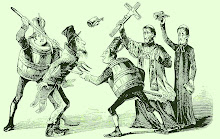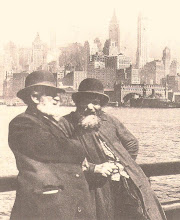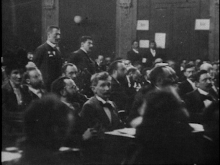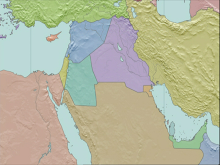There are many scriptures in the Old Testament Bible, written long before Christ, that prophetically testify to the dissembling of the ancient nation of Israel, its loss of sovereignty and subjugation in the holy Land to gentile governors, and eventual scattering among the gentile nations.
But a subsequent re-gathering to the holy Land of a remnant of those Jews thus scattered is also clearly stated in Biblical prophecy given millennia ago. This actual outcome is verifiable today with events in the Middle East that have occurred only in the most recent decades. It is useful to list and review some of the principle examples of these prophecies. The complete texts are available, often with study notes, online at sites such as
http://www.blueletterbible.com/
A first prophetic Old Testament example is found in the Bible’s book of Leviticus (chapter 26).
Following deliverance from centuries of slavery in Egypt, the people of Israel enter the Promised Land. The book of Leviticus is a collection of divine Laws contingent upon the nation of Israel as part of their Covenant relationship with God at that time. It includes keeping the Ten Commandments not to kill, or worship false gods, lie against others, and to keep the Sabbath, for example.
The long book of regulations concludes with a prophetic promise in chapter 26. The NIV Study Bible indicates it was given around the year 1450 BC, or over three and a half thousand years ago. The conditions and contents of the prophecy are relatively simple; one of two things will come to pass in the future dependent on Jewish faithfulness or otherwise in keeping the Covenant rules. Moses tells the nation that abiding in the divine Laws will bring assured blessings such as rain in season, productive land and plenty, peace with nearby nations, absence of pestilence, disease or animal predator.
However, and consistent with how things turned out, should the Laws be neglected or abused, the converse will follow as divine favour and protection would withdraw. This will bring war, subservience to enemies, drought and famine, predation and disease. With continuing neglect of the divine Laws, the adversity would multiply ‘seven times’ (verses 18, 21, 24, 28).
Finally Diaspora is prophesied, where cities lay waste, sanctuaries are desolated and the Land is displaced. The enemy sword will pursue and occupy, scattering the unfaithful Jews among the nations, and the holy Land will rest from its profaned Laws. Among the nations there will be fear and continual alarm for the surviving Jews at the hands of their masters, and even a rustling leaf will terrify - they will clamour over one another to run away. Many Jews will be absorbed nationally or simply perish among the nations.
Even then, while the Land must be recompensed for its profaned Sabbaths (verses 34-5), should they confess their guilt and humble themselves, divine remembrance of the Covenant made with Abraham and his offspring will be called to mind and the Jews, and the holy Land (verse 42) will not be cast away or forgotten (Leviticus 26:31 - 46).
The centuries-long and persecuted Diaspora of the Jews, without a national home, living in fear and wanderings, subject to pillage, exploitation and murder, resulted from the abuse of the divine Laws while resident in their home Land. But the remembrance of the holy Land and the people of the Covenant-promise, and their reinstatement for the sake of their forefathers, has been fulfilled some 3,300 years after the prophecy was given, and the end results are being witnessed now in our time.
There is no analogue to this prophetic vision or its fulfilment in all of history or among any other race. A relatively short Babylonian captivity of the Jews, lasting 70 years that occurred about 600 BC (and itself prophetic), does not begin to match the stronger prophetic parallel descriptions we see also in Deuteronomy 28 to the long Diaspora, and which descriptions can only match the truly horrific and verifiable events of Jerusalem’s protracted sedge and destruction in AD 70, with the dark and fearful centuries that then followed up to (and including) the holocaust atrocity.
Only the Bible foretold this time-trail of consequences and specific events centuries in advance.
A second example is found in Ezekiel.
About 593 BC a long series of biblical prophecy was given to Ezekiel. His entire book of nearly 50 chapters encompasses prophetic warnings similar to and sometimes even quoting those already noted here.
It one prophetic instance of many, Ezekiel is asked to shave his head and beard, a bad omen from any prophet where the head covering was regarded as a sacred symbol and oath. He was divinely instructed to divide the hair on a scale into parts, one third of which must be burned within the city of Jerusalem. Another third must be cut up with the sword outside of the city in the surrounds. And a final third was to be thrown to the wind and scattered in all directions, pursued by the sword.
However, a small fraction would be preserved safely from even this devastation. They were sewn in to the sleeve of the prophet’s garment as a place representing protection and preservation. (Ezekiel 5:1-3). The whole prophetic picture in this small section of the much larger work shows how the Jews will be taken into Babylonian captivity (which happened later in 586 BC), but a remnant will be spared and preserved to return to their Land (which began with a very small number in 538 BC, to be followed by others later).
What is remarkable about this vision is that, like others foretelling the Babylonian captivity, it specks of a further similar episode on an even more destructive and global scale, as if the events of 586 – 538 are just a warning anyway, for in verse four of chapter five, even the small group preserved and protected in Ezekiel’s sleeve undergo a further rout by fire and scattering that will envelop the whole nation of Israel.
What follows in the rest of chapter five through to its end is indistinguishable from events in the historical horror experienced in 70 AD when Jerusalem was sacked and the 2000 year Diaspora began at the hands of the Romans.
The final chapters of Ezekiel look even further in to the future with final hope and eventual deliverance. In its 37th chapter, for example, the state of the whole Jewish peoples in Diaspora is likened to a valley of dry bones, lifeless. The prophet is made to see their revival as the remains assemble and are clothed in flesh. Life is breathed into them from the very winds that had scattered them, and as one nation joined together, they are returned to their ancient home Land.
Again, the divine command to Hosea, about 770 BC, is to illustrate the unfaithfulness and lawlessness of the nation of Israel and foretell the long separation from divine favour this will bring for its peoples. The whole prophecy illustrates how they have behaved like an unfaithful wife and a long probation period will follow.
The specifics of this prophecy began their fulfilment at the start of the Diaspora in AD 70. The Jewish temple and sacrificial system along with the priesthood were destroyed by the Romans and the nation was scattered globally. Synagogues took the place of the temple and rabbis the place of priests. Even so, in the distant latter days, restoration will come. They will not have pursued or served the idols (teraphim) of the nations.
"For the children of Israel shall abide many days without king or prince, without sacrifice or sacred pillar, without ephod or teraphim. Afterward, the children of Israel shall return and seek the LORD their God and David their king. They shall fear the LORD and His goodness in the latter days." (Chapter 3)
This regathering of Israel in the latter days was also foreseen, centuries in advance, by another OT prophect centuries before Christ.
Jeremiah lived ahead of the Babylonian captivity and prophesied its approach, that occurred in the year 586 BC, and its eventual resolution. The Jews as a nation will be removed from the Promised Land but within 70 years their reinstatement will be effected, he said. He describes their return, but like prophecies uttered by other Old Testament visionaries such as Hosea, extra details pertaining to a much longer and more disseminated Diaspora, and latter day re-gathering, are recounted.
Chapter 16 in particular of his book is a summation of the indictment against the unfaithful and lawless nation, their foreseen suffering at the hands of Gentile masters scattered worldwide, but their eventual re-gathering from those lands and ‘from the North’ (v15). Again, we see detail that is not specific to the Babylonian captivity alone, since then the Jews were re-gathered from the East.
But North of Jerusalem stretches the great swathe of Europe and Russia, precisely the direction from which the persecuted Jews of the 2,000-year Diaspora began their recall to the Land of Israel in the early 1900s under the collective banner of Zionism.
Again, chapters 30 – 33 recount the return of the Jews to Israel in detail, and at length, and many of its prophetic features cannot be explained in terms of the return from the Babylonian captivity alone.
Many of the prophets of Israel, as noted, wrote before the first Diaspora in Babylon 600 years before Christ and contain details regarding its completion after 70 years, but included details of a far grater re-gathering to come still further in the future ‘in the latter times.’
The prophet Zechariah lived just after the Babylonian exile and foresaw events regarding the time of Christ as well as far beyond even that. He said that Jesus would be betrayed for 30 pieces of silver and would ride in to Jerusalem on a donkey, for example, and would be a direct descendant of the Jewish king David (c 1000 BC). Zechariah deals with many of these points in chapters 6 to 9 of his prophecy.
But the final five chapters deal with ‘end time’ (14:1) events due to unfold long after Messiah’s first advent around 30 AD. The Jews will be scattered again or sawn among the nations, which occurred in 70 AD, and from where they will call again for divine deliverance. The way will be opened for their return and they will be re gathered from different global directions in numbers that will fill the holy Land. (10:6-12).
But the city of Jerusalem itself will become a great burden and problem to all nations, just as it has become today (12:2-3). Events yet to be fulfilled, and involving the Messiah’s second advent, follow in the vision of Zechariah (12:10).
(9may17)
Introduction
ONE HUNDRED AND FORTY YEARS BEFORE the actual events came to fruition in the Middle East, two dedicated Bible scholars predicted accurately several key years in the then approaching conflict for tenure of the holy Land and Jerusalem, involving a long prophesised regathering of the Jews to their Promised Land, after nearly 2000 years of Diaspora.
Doctors Clarke and Guinness pointed well in advance to the coming years 1902, 1917, 1947-8 and 1967 AD, having based their predictions on the 2,500 year old Biblical book of Daniel.
Not only did their advance forecasts prove accurate decades later, but those key 'Signpost Years’ continue to mark events and developments in the holy Land, ever since their occurrence in modern times, that now represent the specific themes of serious contention in the struggle for Peace in that region today.
These following NOTES explain the rational behind the Clarke-Guinness thinking in as fast and concise a form as possible, and elaborations will follow. A second critical aim here is not to prove 'The Signpost Years' correct, but rather to use the scientific approach of attempting their falsification first. You can help either way by passing on any objective comments to this site.
PART 1 Is an Introduction and looks at each of the Signpost Years as they were foretold in the writings of Guinness and Clarke. It looks at many of the side issues and has a number of detailed footnotes.
PART 2 Looks at the period 1901 – 1903, and the first of the Signpost Years predicted by Clarke in 1825. This part explains the huge significance of the period and sets the scene for a further link that comes in Part 4.
PART 3 Begins to address some of the typical questions that might arise in the mind of the reader regarding the Signpost Years. Items are added to this from time to time as new considerations are brought to light. Again, feel free to contribute any comments that will add to those pages.
PART 4 Looks at the Signpost Years in the light of the last 6 months of Christ’s Ministry, and especially the last week of messages He imparted to His followers for the future. It ties directly back into PART 2.
*****************************************************
TO READ SPECIFIC 'CHAPTERS' CLICK ONE OF THE 'QUICK LINKS' LISTED DIRECTLY BELOW, AND TO READ OR ADD COMMENTS, CLICK 'POST COMMENT' AT THE END OF EACH CHAPTER THAT WILL OPEN AN EMAIL BOX TO SEND TO THIS BLOG.
AGAIN YOU CAN SIMPLY EMAIL TO:
karl@thesignpostyears.com
Click on QUICK LINKS to Parts 1 to 4 of the Signpost Notes:
Part 1: Introduction, Timelines, Conclusion.
Part 2: The SignPost Year 1902 AD and Max Nordau
Part 3: Q & A on the Signpost Years
Part 4: Jesus and the Signpost Years
Doctors Clarke and Guinness pointed well in advance to the coming years 1902, 1917, 1947-8 and 1967 AD, having based their predictions on the 2,500 year old Biblical book of Daniel.
Not only did their advance forecasts prove accurate decades later, but those key 'Signpost Years’ continue to mark events and developments in the holy Land, ever since their occurrence in modern times, that now represent the specific themes of serious contention in the struggle for Peace in that region today.
These following NOTES explain the rational behind the Clarke-Guinness thinking in as fast and concise a form as possible, and elaborations will follow. A second critical aim here is not to prove 'The Signpost Years' correct, but rather to use the scientific approach of attempting their falsification first. You can help either way by passing on any objective comments to this site.
PART 1 Is an Introduction and looks at each of the Signpost Years as they were foretold in the writings of Guinness and Clarke. It looks at many of the side issues and has a number of detailed footnotes.
PART 2 Looks at the period 1901 – 1903, and the first of the Signpost Years predicted by Clarke in 1825. This part explains the huge significance of the period and sets the scene for a further link that comes in Part 4.
PART 3 Begins to address some of the typical questions that might arise in the mind of the reader regarding the Signpost Years. Items are added to this from time to time as new considerations are brought to light. Again, feel free to contribute any comments that will add to those pages.
PART 4 Looks at the Signpost Years in the light of the last 6 months of Christ’s Ministry, and especially the last week of messages He imparted to His followers for the future. It ties directly back into PART 2.
*****************************************************
TO READ SPECIFIC 'CHAPTERS' CLICK ONE OF THE 'QUICK LINKS' LISTED DIRECTLY BELOW, AND TO READ OR ADD COMMENTS, CLICK 'POST COMMENT' AT THE END OF EACH CHAPTER THAT WILL OPEN AN EMAIL BOX TO SEND TO THIS BLOG.
AGAIN YOU CAN SIMPLY EMAIL TO:
karl@thesignpostyears.com
Click on QUICK LINKS to Parts 1 to 4 of the Signpost Notes:
Part 1: Introduction, Timelines, Conclusion.
Part 2: The SignPost Year 1902 AD and Max Nordau
Part 3: Q & A on the Signpost Years
Part 4: Jesus and the Signpost Years
Monday, 6 April 2009
The SignPost Years
Click on QUICK LINKS 1 to 3 here for Signpost Year Notes:
Part 1: Introduction, Timelines, Conclusion.
Part 2: The SignPost Year 1902 AD and Max Nordau
Part 3: Q & A on the Signpost Years
Part 4: Jesus and the Signpost Years
Part 1: Introduction, Timelines, Conclusion.
Part 2: The SignPost Year 1902 AD and Max Nordau
Part 3: Q & A on the Signpost Years
Part 4: Jesus and the Signpost Years



























